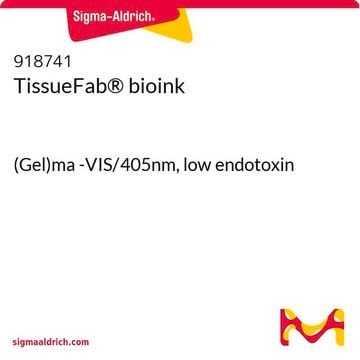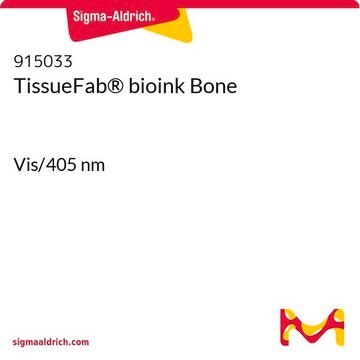906905
TissueFab® bioink
Sacrificial
Synonym(s):
PEG-PPG-PEG, Poloxamer F127, Sacrificial bioink
About This Item
Recommended Products
description
0.2 μm sterile filtered
suitable for 3D bioprinting applications
form
viscous liquid
impurities
≤5 CFU/g Bioburden (Fungal)
≤5 CFU/g Bioburden (Total Aerobic)
color
colorless to pale yellow
pH
6.5-7.5
application(s)
3D bioprinting
storage temp.
2-8°C
Looking for similar products? Visit Product Comparison Guide
General description
Application
Packaging
Other Notes
- Optimize printing conditions (e.g., nozzle diameter, printing speed, printing pressure, temperature, cell density) for the features of your 3D printer and your application.
- Reduce bubble formation. Air bubbles in bioink may hamper bioprinting. Carefully handle the bioink when you mix and transfer it to avoid bubble formation. Do not vortex or shake vigorously.
Procedure
1. Prepare bioink: Keep TissueFab® - Sacrificial Bioink on ice to prevent gelation and gently invert the bioink to make a homogeneous solution. DO NOT vortex or shake vigorously. Transfer TissueFab® - Sacrificial Bioink into the desired printer cartridge.
2. Bioprint: Warm TissueFab® - Sacrificial Bioink in the printer cartridge to room temperature for 10–15 minutes to induce gelation. Follow the 3D printer manufacturer′s instructions. Load the print cartridge onto the 3D printer and print directly onto a Petri dish or into multi-well plates. Adjust the flow according to nozzle diameter, printing speed, printing pressure, and temperature. TissueFab® - Sacrificial Bioink can be printed in tandem with cell laden bioinks using additional printheads.
3. Optional Crosslink: If additional bioinks are used, crosslink the bioprinted structure before removing sacrificial scaffold following bioink instructions.
4. Remove sacrificial scaffold: Cool printed structure to 4 °C for at least 5 minutes. Rinse or perfuse with cold PBS.
5. Culture cells: Culture the bioprinted tissue with appropriate cell culture medium following standard tissue culture procedures.
Legal Information
Storage Class Code
10 - Combustible liquids
WGK
WGK 1
Choose from one of the most recent versions:
Certificates of Analysis (COA)
Don't see the Right Version?
If you require a particular version, you can look up a specific certificate by the Lot or Batch number.
Already Own This Product?
Find documentation for the products that you have recently purchased in the Document Library.
Articles
Bioinks enable 3D bioprinting of tissue constructs for drug screening and transplantation; select suitable bioinks for specific tissue engineering.
Learn how 3D bioprinting is revolutionizing drug discovery with highly-controllable cell co-culture, printable biomaterials, and its potential to simulate tissues and organs. This review paper also compares 3D bioprinting to other advanced biomimetic techniques such as organoids and organ chips.
Professor Shrike Zhang (Harvard Medical School, USA) discusses advances in 3D-bioprinted tissue models for in vitro drug testing, reviews bioink selections, and provides application examples of 3D bioprinting in tissue model biofabrication.
Protocols
Frequently asked questions (FAQs) for KAPA SYBR® FAST One-Step qRT-PCR Kits.
Our team of scientists has experience in all areas of research including Life Science, Material Science, Chemical Synthesis, Chromatography, Analytical and many others.
Contact Technical Service








